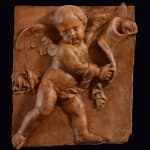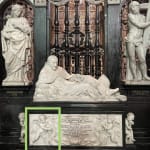
Hieronymus II Duquesnoy, Funerary Monument for Bishop Antonius Triest, Saint Bavo Cathedral, Ghent.
Hieronymus Duquesnoy the Younger (Brussels 1602 - 1654 Ghent) (attributed)
Hieronymus Duquesnoy the Younger was born in Brussels in 1602. His father, Hieronymus the Elder, was court sculptor to the Archdukes Albrecht and Isabella, rulers of the Spanish Netherlands, and is mainly known as the creator of the world famous Manneken Pis, a bronze fountain sculpture in central Brussels depicting a little boy urinating into the fountain’s basin. Hieronymus the Younger trained in his father’s workshop, alongside his older brother François (1597 - 1643), who left for Rome in 1618. By 1622 at the latest, Hieronymus had joined him there. By that time François had already become quite successful, and Hieronymus assisted him in his commissions, for instance on the work on the baldacchino in Saint Peter’s, for which a payment in his name was received in 1627. Both brothers were painted by Anthony van Dyck, who spent time in Rome in 1622 and 1623.
There is no mention of Hieronymus in the records from 1627 onwards, until 1641, when he is recorded as having lived in Florence for a period of nine months with the Brussels-born silversmith André Ghysels - possibly to assist in and oversee the production of designs of his brother - after returning from a trip to Spain. From 1641 until 1643 he is also recorded in Rome again, living with François in the the parish of San Lorenzo in Lucina. The record of a trip to Spain has led many authors to believe that our sculptor spent over a decade in Spain or Portugal, accounting for his absence from the sources. However, recently it has convincingly been argued that he probably stayed in Rome for most of this period, working on projects alongside his brother. François’ poor health at times, in addition to his great workload, would in any case have necessitated regular assistance from a trusted collaborator.
In 1643 the brothers left Rome together - another indication of their collaboration - on a trip to France at the invitation of the French king extended to François to become the director of a yet to be established department of painting and sculpture called ‘Académie Royale de Peinture et de Sculpture’. However, after arriving in Livorno François died and Hieronymus travelled on to his hometown Brussels, taking his brother’s chests of designs and models with him. He quickly became well sought- after, executing various commissions for local churches. In 1651 he became "architecte, statuaire et sculpteur de la Cour” at the Brussels court, carving a bust of the Archduke Leopold Wilhelm of Austria (now kept in the Kunsthistorisches Museum in Vienna).
Already in 1642 Antonius Triest, bishop of Ghent, had sent a painting of himself to François to be used as the basis for a portrait bust. Furthermore, he requested the artist to design and sculpt a funerary monument. The bust, which is now kept in the Louvre, was completed in 1643 or ’44 and is signed by Hieronymus, although it was most probably based on preliminary designs by François and may have even been partially executed by him. As the monument however was made almost a decade later, there can be no doubt it was designed and executed by Hieronymus. It is known he made several terracotta modelli for the monument; his model for the Virgin Mary is now kept at the KMSKA in Antwerp (King Baudouin Foundation, collection Van Herck, inv. no. 71). Our terracotta, which was recently rediscovered in a private collection, is a life-size model for one of the two putti holding up the cartouche below (see illustration).
Provenance
Private collection, The Netherlands;
Private collection, Antwerp.


